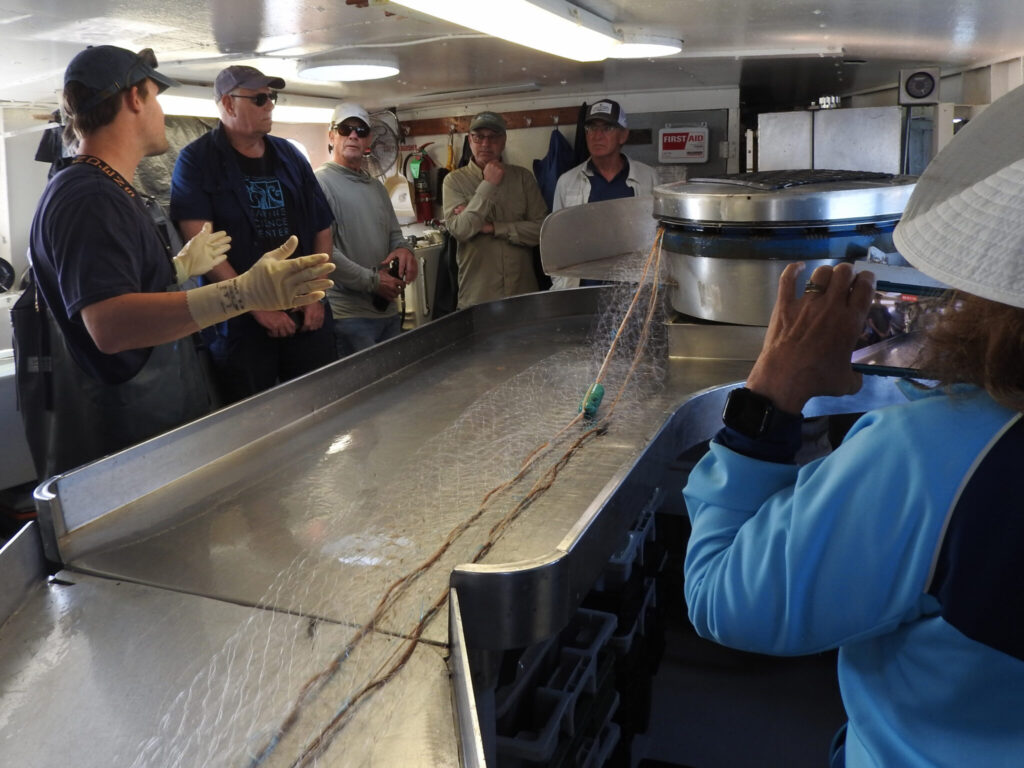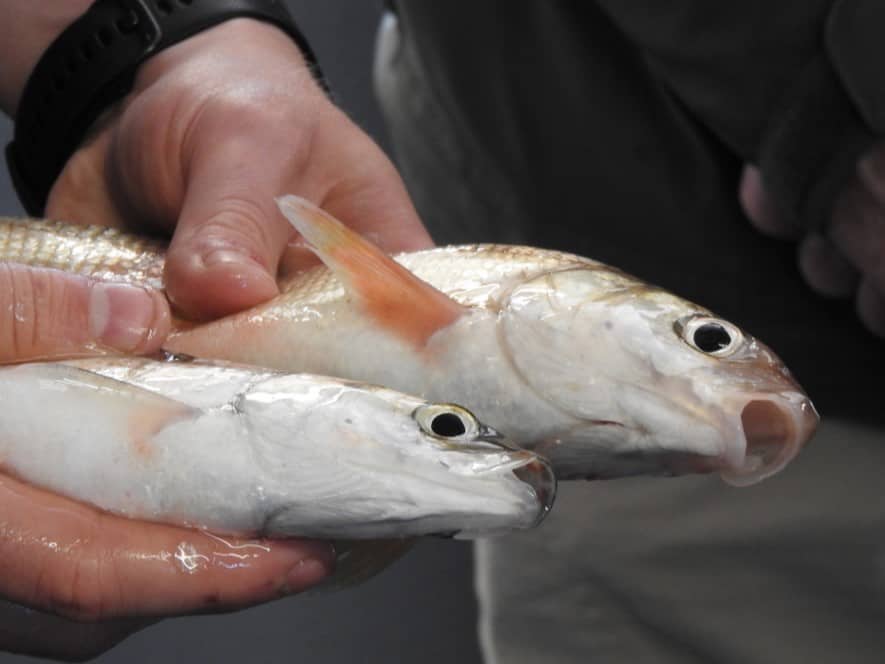By Emily Stone
Naturalist/Education Director, Cable Natural History Museum
The boat engine rumbled and machinery whirred as a gillnet rose from the depths of Lake Superior. Captain Ross Lind managed the throttle so that the 55-foot-long gillnet-tug-turned-research-vessel named Hack Noyes moved toward the net at the same speed the net lifter reeled it in.
A group of interested adults on this Museum-sponsored field trip gathered around the equipment. We were mesmerized by the clicking of the metal teeth on the spinning drum as they gripped and then released the line, and by the lengths of delicate nylon net attached to the line. Capable hands guided the net down a long, stainless-steel worktable and into the storage tub. (Check out the Museum’s Reels on Instagram and Facebook if you want to see a video of this operation.)
Gillnets look like a long tennis net, anchored by weights along the lake bottom and held vertical by floats. Small fish swim right through, but bigger fish get caught. Whether a DNR biologist or a commercial fisherman is setting the net, they can choose the fish they target by the size of the mesh and the depth of set.
A flash of silver rounded the drum. The fish landed on the worktable and Dray Carl, Fisheries Biologist for the Wisconsin DNR, freed it from the filaments. Another fish, and then another and another landed on the table. They all looked about the same to my untrained eye, but after lining them up, Dray began to teach us about the different species we’d caught.
There was one adult whitefish. At 17.7” long it was of legal size, and Dray put it on ice to take to Bodin Fisheries processing plant, which was the next stop for all of us on the field trip. The DNR tries not to waste the fish they catch as part of their research and monitoring efforts, and their catch is factored into the fishing quotas. Quotas are negotiated between the state, the Red Cliff Band of Lake Superior Chippewa, and the Bad River Tribe, and these entities manage the fishery cooperatively.

Three young whitefish remained on the table, next to two cisco. Other than being slightly different shades of silver, I couldn’t tell them apart. These two nearshore fish species are in the same genus, and hang out in 50-250 feet of water. Whitefish, though, feed on the bottom of the lake, nibbling on insects and snails with their down-turned mouth. Cisco feed throughout the water column on zooplankton and other critters right in front of their forward-facing mouth. Dray held them up, and now even I could see the difference.

The third fish species on the table was a rainbow smelt. Though introduced from the Atlantic Coast, smelt gained a huge following during their heyday, when anyone with a net could catch hundreds at the mouth of a creek during a spawning run. Smelt can be beneficial as a prey species, but they also eat young cisco and whitefish. Now that smelt numbers have moderated, whitefish and cisco are able to increase their populations again.
In fact, current numbers of one-year-old cisco are higher than biologists have seen since at least 1978. This boom was spawned in the fall of 2021, and hatched in 2022. Their reproductive success was thought to be tied to high ice cover, but the new hypothesis is that our recent late springs have provided the cold water that the fish need at just the right time.
While cisco populations are high all over the lake, “the highest densities of the little cisco have been observed in Wisconsin waters,” Dray told me proudly. Wisconsin waters only include 7% of the surface area of Lake Superior, but there are more fish harvested out of this jurisdiction than the rest of the lake combined.
Part of that has to do with the number of fisherman out there trying to catch fish. Much of Minnesota’s North Shore and Canada are pretty wild and host relatively few commercial fishing operations. A bigger reason? Wisconsin has more shallow water. Eighty percent of Lake Superior is more than 250 feet deep. Sunlight doesn’t penetrate into those depths, and therefore can’t jumpstart the food chain. In the shallow waters of the St. Louis River Estuary, the Apostle Islands, Chequamegon Bay, and Kakagon Slough, sunlight powers algae, and streams bring in nutrients from the uplands, too.
When you mix that productivity with a wide variety of habitats that support a diversity of species as they grow and reproduce, you get a lot of fish. So many fish are born in Wisconsin waters that they disperse throughout the rest of the lake.
Dray did a fantastic job of explaining the biology and management of the Wisconsin fishery on Lake Superior. To my delight, he even brought it back to geology. About a billion years ago, the Mid-Continent Rift tried to rip apart North America, right through where Lake Superior is today. The lava that erupted from immense seam volcanoes in the rift became the steeply dipping bedrock on the North Shore of Lake Superior. Sandstone filled in the resulting basin, and glaciers carved that softer rock into the islands and bays—and fish habitat—of today’s Wisconsin waters. As the land rebounds from the weight of the glaciers, the lake is tilting southwest to flood the mouth of the St. Louis River and create more great habitat there.
This Friday, as I nibble on a locally caught fillet of Lake Superior whitefish or cisco, I’ll be quietly thanking all the people (and geology!) who contribute to the health of Wisconsin’s fishery.
Emily’s award-winning second book, Natural Connections: Dreaming of an Elfin Skimmer, is available to purchase at www.cablemuseum.org/books and at your local independent bookstore, too.
For more than 50 years, the Cable Natural History Museum has served to connect you to the Northwoods. Our new exhibit: “The Northwoods ROCKS!” is open now! Our Summer Calendar of Events is ready for registration! Follow us on Facebook, Instagram, YouTube, and www.cablemuseum.org to see what we are up to.
